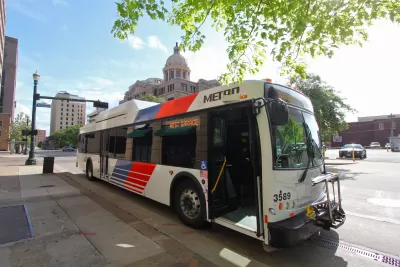Following an "overnight" system redesign, Houston Metro ridership and frequency is up across the board. Its high frequency bus service now rivals that of peer cities on weekends.

Claudia Preciado reports on good news from Houston: an August 2015 bus grid "reimagining" seems to be succeeding. "Typically, service changes are done through a comprehensive operational analysis, followed by an intensive implementation plan of incremental changes over a lengthy amount of time. Metro implemented the entire system redesign in August 2015…overnight. Nearly every bus route was altered with the goal of creating a high-frequency, seven days a week system that increased access to people and jobs."
Houston labors under a reputation for sprawl and sub-par transit. "[Houston's] previous system had 11 lines of high frequency transit lines, defined as service with 15 minute headways or better. Only 25% of the ridership base had access to frequent service under this network."
But that seems to be changing. "On August 16, 2015, the new service redesign enabled riders to travel even further by increasing frequencies, implementing route modifications, and ensuring the transit system served demand. The change meant that 72% of the ridership base now had access to 22 lines with frequent service, seven days a week."
FULL STORY: Houston - the next great (transit) city?

Trump Administration Could Effectively End Housing Voucher Program
Federal officials are eyeing major cuts to the Section 8 program that helps millions of low-income households pay rent.

Planetizen Federal Action Tracker
A weekly monitor of how Trump’s orders and actions are impacting planners and planning in America.

The 120 Year Old Tiny Home Villages That Sheltered San Francisco’s Earthquake Refugees
More than a century ago, San Francisco mobilized to house thousands of residents displaced by the 1906 earthquake. Could their strategy offer a model for the present?

HSR Reaches Key Settlement in Northern California City
The state’s high-speed rail authority reached an agreement with Millbrae, a key city on the train’s proposed route to San Francisco.

Washington State Legislature Passes Parking Reform Bill
A bill that would limit parking requirements for new developments is headed to the governor’s desk.

Missouri Law Would Ban Protections for Housing Voucher Users
A state law seeks to overturn source-of-income discrimination bans passed by several Missouri cities.
Urban Design for Planners 1: Software Tools
This six-course series explores essential urban design concepts using open source software and equips planners with the tools they need to participate fully in the urban design process.
Planning for Universal Design
Learn the tools for implementing Universal Design in planning regulations.
Ada County Highway District
Clanton & Associates, Inc.
Jessamine County Fiscal Court
Institute for Housing and Urban Development Studies (IHS)
City of Grandview
Harvard GSD Executive Education
Toledo-Lucas County Plan Commissions
Salt Lake City
NYU Wagner Graduate School of Public Service


























